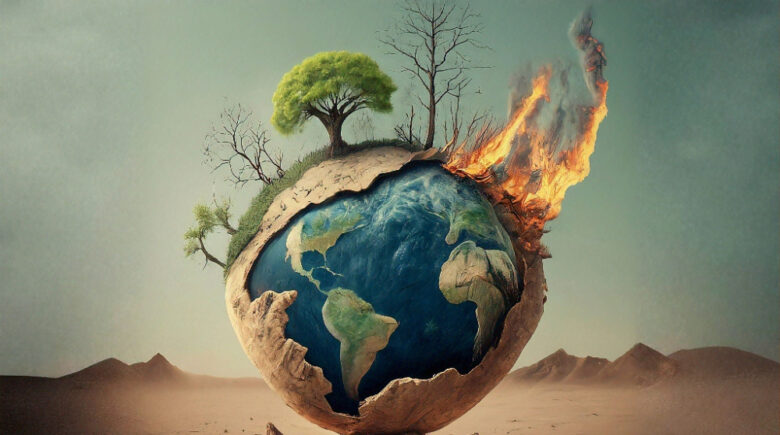2024 Wasn’t Just Hot. It Was a Warning Shot Echoing Through Every Corner of the Globe
You felt it, didn’t you? That eerie stillness before a heatwave crushes down like a heavy quilt soaked in fire. That strange déjà vu of yet another “once-in-a-century” storm rolling across the skyline. Climate change isn’t tapping politely on the door anymore—it’s kicked it open, marched in, and brought the kind of weather chaos that reads more like science fiction than a five-day forecast.
Let’s talk about 2024, the year the thermometer didn’t just whisper, it screamed. Global temperatures surged past the long-dreaded 1.5°C threshold—a line drawn not in sand, but in ice sheets and fragile ecosystems, and now it’s smeared by the relentless heat. From NASA to Copernicus, every climate monitoring body agreed: this wasn’t a statistical fluke. It was a boiling point.
A Broken Record That Broke the Planet
Temperatures ranged from 1.47°C to 1.62°C above pre-industrial norms, which might seem like decimals, but those tenths of a degree? They’re tectonic. They’re the difference between drought and devastation, between a storm and a superstorm. Between survival and the stories we tell about loss.
We’ve been warned. The Paris Agreement set its sights on keeping things under 2°C—ideally 1.5. That number wasn’t plucked out of a hat. It was calculated, debated, pleaded over. But this year, we blew past it. And though climate agreements look at decades, not single years, 2024 is a flare shot into the sky. A message: we’re not approaching the cliff edge anymore. We’re teetering.
Weather, But Turned Up to Eleven
The shift isn’t subtle. It’s torrential. The IPCC, never known for hyperbole, now categorizes the link between global warming and extreme weather as a fact, full stop. The jet stream? Unraveling. Rainfall patterns? Acting out. Temperatures? Off the charts.
Heatwaves used to be seasonal visitors. Now they’re overstaying their welcome, setting up shop in regions that once boasted temperate charm. Meanwhile, droughts creep across landscapes, turning once-fertile fields into dust bowls. And when it rains—oh, it pours. Cities are drowning under what used to be a month’s rain falling in a single day.
Hurricanes, typhoons, cyclones—whatever you call them—are becoming beasts. Supercharged by ocean heat, they now roar in with winds that can shear roofs clean off buildings, dumping walls of water and displacing hundreds of thousands. It’s not just the scale—it’s the layering. A heatwave followed by wildfire. A drought followed by a deluge. Weather systems, colliding like drunk titans.
What’s Causing the Mayhem? Let’s Break It Down
Imagine the atmosphere as a giant sponge. Warmer air holds more moisture—about 7% more for every 1°C increase. So when that sponge gets squeezed? You get floods that turn streets into rivers, cities into archipelagos. At the same time, higher heat evaporates more water from the land. Soils crack, crops wither, reservoirs shrink. This isn’t weather—it’s a heat-slinging, drought-crafting, flood-conjuring hydrological circus.
It gets loopier. Dry soils reflect more sunlight, which makes the surface hotter, which dries things out further. Feedback loop activated. You’ve just entered the drought-heatwave spiral. And let’s not forget ocean temps—those vast blue heat sinks are now feeding hurricanes like protein shakes to bodybuilders.
More heat, more energy. More energy, more destruction.
People Are Paying the Price—Big Time
We talk about trillions lost in damage like it’s Monopoly money. It isn’t. From 2014 to 2023, climate disasters swallowed about $2 trillion globally. In the last two years alone? $451 billion. That’s roads washed away, crops lost, homes razed, economies bruised and buckling.
In the U.S., billion-dollar disasters are now so common they’re practically seasonal. And in the Global South, a single extreme event can sink an entire year’s economy. We’re not just talking about insurance premiums and GDP dips. We’re talking about families displaced, children out of school, communities torn from their roots.
Climate change deepens inequality. The rich rebuild; the poor relocate—or try to. Women, children, the elderly, the disabled—they’re often the first affected and the last to recover. From heatstroke in urban slums to cholera outbreaks after floods, the health impacts are stacking up, layer after layer.
So What Do We Do? Is There an “Undo” Button?
There’s no Ctrl+Z, but there is action. And it starts with stopping the thing that’s fueling all this: emissions. Fossil fuels—coal, oil, gas—need to exit stage left. That means flipping the switch to renewables, fast. Solar, wind, geothermal—clean energy isn’t sci-fi anymore. It’s here. And it works.
Energy efficiency needs to stop being boring and start being policy. Better buildings. Smarter transit. Farms that trap carbon instead of belching it. Forests left standing. Wetlands restored. Let’s turn carbon sinks into everyday heroes.
But even if we shut off the tap tomorrow, the water’s already rising. That’s why adaptation matters. Early warning systems, flood defenses, green infrastructure, drought-resilient seeds. We need to armor up—not just in concrete and tech, but with foresight and community planning.
It’s not all gloom. Brazil’s water cistern program is helping families survive dry seasons. The Netherlands is teaching rivers how to flood gracefully. India’s heatwave action plans are saving lives before thermometers explode. Innovation is everywhere, if we know where to look—and if we scale it up, fast.
This Isn’t a Drill. This Is the Moment.
The heat of 2024 isn’t just another weather stat. It’s a story. One told in blistered crops, in swollen rivers, in families seeking higher ground. But it’s also a story we’re still writing.
Governments? Step up. Pass the laws. Fund the transitions. Businesses? Get cleaner. Faster. Smarter. Communities? Demand change. Adapt. Support one another.
And you? You matter. What you eat, how you commute, where you bank—it all adds up. This isn’t about guilt. It’s about power. Collective power.
Yes, time is short. But agency still exists. The question isn’t whether we can respond. The question is: will we?
Choose action. Choose equity. Choose heat shields over hand-wringing. The future is watching. And it’s not waiting.
2024 Wasn’t Just Hot. It Was a Warning Shot Echoing Through Every Corner of the Globe
You felt it, didn’t you? That eerie stillness before a heatwave crushes down like a heavy quilt soaked in fire. That strange déjà vu of yet another “once-in-a-century” storm rolling across the skyline. Climate change isn’t tapping politely on the door anymore—it’s kicked it open, marched in, and brought the kind of weather chaos that reads more like science fiction than a five-day forecast.
Let’s talk about 2024, the year the thermometer didn’t just whisper, it screamed. Global temperatures surged past the long-dreaded 1.5°C threshold—a line drawn not in sand, but in ice sheets and fragile ecosystems, and now it’s smeared by the relentless heat. From NASA to Copernicus, every climate monitoring body agreed: this wasn’t a statistical fluke. It was a boiling point.
A Broken Record That Broke the Planet
Temperatures ranged from 1.47°C to 1.62°C above pre-industrial norms, which might seem like decimals, but those tenths of a degree? They’re tectonic. They’re the difference between drought and devastation, between a storm and a superstorm. Between survival and the stories we tell about loss.
We’ve been warned. The Paris Agreement set its sights on keeping things under 2°C—ideally 1.5. That number wasn’t plucked out of a hat. It was calculated, debated, pleaded over. But this year, we blew past it. And though climate agreements look at decades, not single years, 2024 is a flare shot into the sky. A message: we’re not approaching the cliff edge anymore. We’re teetering.
Weather, But Turned Up to Eleven
The shift isn’t subtle. It’s torrential. The IPCC, never known for hyperbole, now categorizes the link between global warming and extreme weather as a fact, full stop. The jet stream? Unraveling. Rainfall patterns? Acting out. Temperatures? Off the charts.
Heatwaves used to be seasonal visitors. Now they’re overstaying their welcome, setting up shop in regions that once boasted temperate charm. Meanwhile, droughts creep across landscapes, turning once-fertile fields into dust bowls. And when it rains—oh, it pours. Cities are drowning under what used to be a month’s rain falling in a single day.
Hurricanes, typhoons, cyclones—whatever you call them—are becoming beasts. Supercharged by ocean heat, they now roar in with winds that can shear roofs clean off buildings, dumping walls of water and displacing hundreds of thousands. It’s not just the scale—it’s the layering. A heatwave followed by wildfire. A drought followed by a deluge. Weather systems, colliding like drunk titans.
What’s Causing the Mayhem? Let’s Break It Down
Imagine the atmosphere as a giant sponge. Warmer air holds more moisture—about 7% more for every 1°C increase. So when that sponge gets squeezed? You get floods that turn streets into rivers, cities into archipelagos. At the same time, higher heat evaporates more water from the land. Soils crack, crops wither, reservoirs shrink. This isn’t weather—it’s a heat-slinging, drought-crafting, flood-conjuring hydrological circus.
It gets loopier. Dry soils reflect more sunlight, which makes the surface hotter, which dries things out further. Feedback loop activated. You’ve just entered the drought-heatwave spiral. And let’s not forget ocean temps—those vast blue heat sinks are now feeding hurricanes like protein shakes to bodybuilders.
More heat, more energy. More energy, more destruction.
People Are Paying the Price—Big Time
We talk about trillions lost in damage like it’s Monopoly money. It isn’t. From 2014 to 2023, climate disasters swallowed about $2 trillion globally. In the last two years alone? $451 billion. That’s roads washed away, crops lost, homes razed, economies bruised and buckling.
In the U.S., billion-dollar disasters are now so common they’re practically seasonal. And in the Global South, a single extreme event can sink an entire year’s economy. We’re not just talking about insurance premiums and GDP dips. We’re talking about families displaced, children out of school, communities torn from their roots.
Climate change deepens inequality. The rich rebuild; the poor relocate—or try to. Women, children, the elderly, the disabled—they’re often the first affected and the last to recover. From heatstroke in urban slums to cholera outbreaks after floods, the health impacts are stacking up, layer after layer.
So What Do We Do? Is There an “Undo” Button?
There’s no Ctrl+Z, but there is action. And it starts with stopping the thing that’s fueling all this: emissions. Fossil fuels—coal, oil, gas—need to exit stage left. That means flipping the switch to renewables, fast. Solar, wind, geothermal—clean energy isn’t sci-fi anymore. It’s here. And it works.
Energy efficiency needs to stop being boring and start being policy. Better buildings. Smarter transit. Farms that trap carbon instead of belching it. Forests left standing. Wetlands restored. Let’s turn carbon sinks into everyday heroes.
But even if we shut off the tap tomorrow, the water’s already rising. That’s why adaptation matters. Early warning systems, flood defenses, green infrastructure, drought-resilient seeds. We need to armor up—not just in concrete and tech, but with foresight and community planning.
It’s not all gloom. Brazil’s water cistern program is helping families survive dry seasons. The Netherlands is teaching rivers how to flood gracefully. India’s heatwave action plans are saving lives before thermometers explode. Innovation is everywhere, if we know where to look—and if we scale it up, fast.
This Isn’t a Drill. This Is the Moment.
The heat of 2024 isn’t just another weather stat. It’s a story. One told in blistered crops, in swollen rivers, in families seeking higher ground. But it’s also a story we’re still writing.
Governments? Step up. Pass the laws. Fund the transitions. Businesses? Get cleaner. Faster. Smarter. Communities? Demand change. Adapt. Support one another.
And you? You matter. What you eat, how you commute, where you bank—it all adds up. This isn’t about guilt. It’s about power. Collective power.
Yes, time is short. But agency still exists. The question isn’t whether we can respond. The question is: will we?
Choose action. Choose equity. Choose heat shields over hand-wringing. The future is watching. And it’s not waiting.



